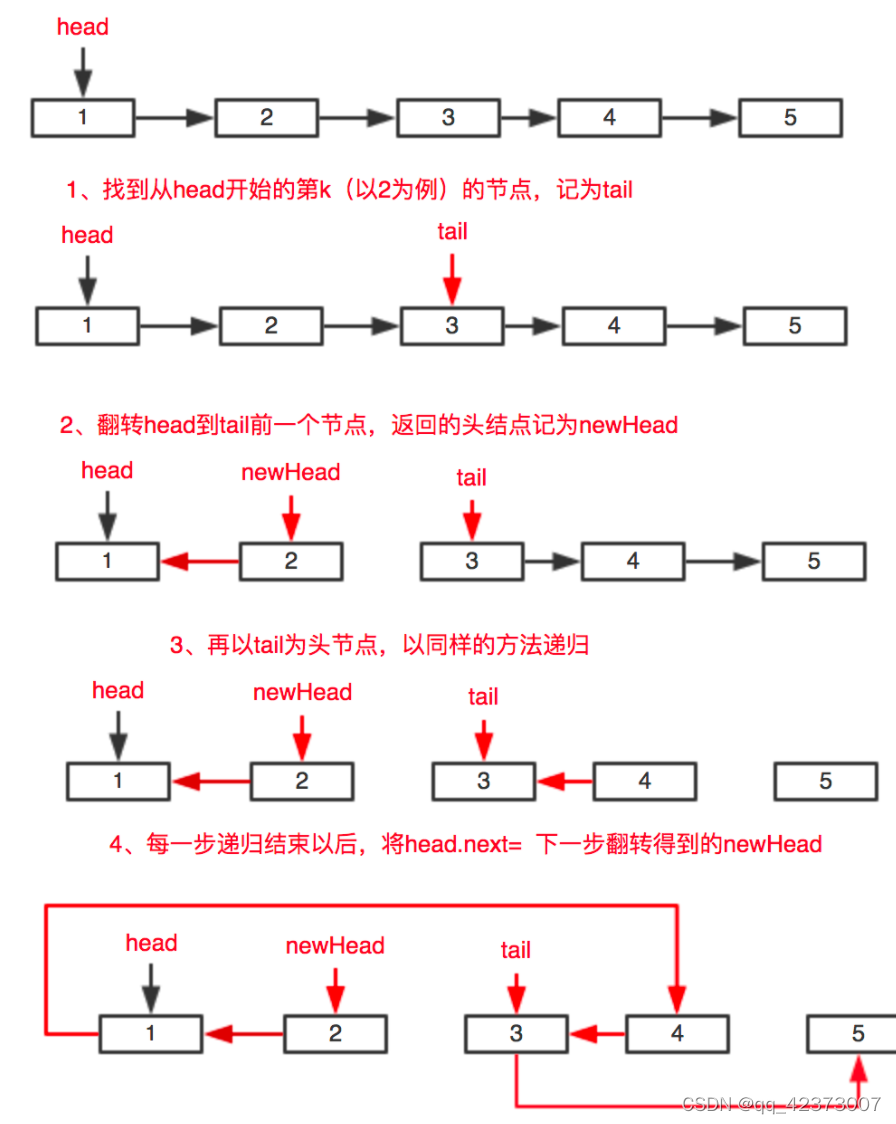k个一组反转链表(25)
前置知识1.2.
- 反转整个链表
// 反转以 a 为头结点的链表
ListNode reverse(ListNode a) {
ListNode pre, cur, nxt;
pre = null; cur = a; nxt = a;
while (cur != null) {
nxt = cur.next;
// 逐个结点反转
cur.next = pre;
// 更新指针位置
pre = cur;
cur = nxt;
}
// 返回反转后的头结点
return pre;
}
// 反转以 a 为头结点的链表
ListNode reverse(ListNode a) {
ListNode pre, cur, nxt;
pre = null; cur = a; nxt = a;
while (cur != null) {
nxt = cur.next;
// 逐个结点反转
cur.next = pre;
// 更新指针位置
pre = cur;
cur = nxt;
}
// 返回反转后的头结点
return pre;
}
- 给定开始结点和结束结点反转链表
上面是因为结束结点为空,所以while循环是cur!=null,如果结束结点不为空,则while循环中条件是cur!=b,a到b是左闭右开转态
将结束结点带入循环内判断就行了
// 反转以a到b之间的链表
ListNode reverse(ListNode a,ListNode b) {
ListNode pre, cur, nxt;
pre = null; cur = a; nxt = a;
while (cur != b) {
nxt = cur.next;
// 逐个结点反转
cur.next = pre;
// 更新指针位置
pre = cur;
cur = nxt;
}
// 返回反转后的头结点
return pre;
}
- 进行解题思路
1、找到待翻转的k个节点(注意:若剩余数量小于 k 的话,则不需要反转,因此直接返回待翻转部分的头结点即可)。
2、对其进行翻转。并返回翻转后的头结点(注意:翻转为左闭又开区间,所以本轮操作的尾结点其实就是下一轮操作的头结点)。
3、对下一轮 k 个节点也进行翻转操作。
4、将上一轮翻转后的尾结点指向下一轮翻转后的头节点,即将每一轮翻转的k的节点连接起来。
- K个一组反转
ListNode reverseKGroup(ListNode head, int k) {
if (head == null) return null;
// 区间 [a, b) 包含 k 个待反转元素
ListNode a, b;
a = b = head;
for (int i = 0; i < k; i++) {
// 不足 k 个,不需要反转,base case
if (b == null) return head;
b = b.next;
}
// 反转前 k 个元素
ListNode newHead = reverse(a, b);
// 递归反转后续链表并连接起来
a.next = reverseKGroup(b, k);
return newHead;
}
ListNode reverse(ListNode a, ListNode b) {
ListNode pre, cur, nxt;
pre = null; cur = a; nxt = a;
// while 终止的条件改一下就行了
while (cur != b) {
nxt = cur.next;
cur.next = pre;
pre = cur;
cur = nxt;
}
// 返回反转后的头结点
return pre;
}
环形链表(141)
/**
* Definition for singly-linked list.
* class ListNode {
* int val;
* ListNode next;
* ListNode(int x) {
* val = x;
* next = null;
* }
* }
*/
public class Solution {
public boolean hasCycle(ListNode head) {
if(head==null||head.next==null)
return false;
ListNode fast=head;
ListNode slow=head;
while(fast.next!=null&&fast.next.next!=null){
fast=fast.next.next;
slow=slow.next;
if(fast==slow){
return true;
}
}
return false;
}
}
环形链表||(142)
解题思路参考https://leetcode-cn.com/problems/linked-list-cycle-ii/solution/linked-list-cycle-ii-kuai-man-zhi-zhen-shuang-zhi-/
参考了它的代码
使用快慢指针。快的每次走两步,慢的每次走一步。
另一种清晰的解释
L=N*C-X
也就是说,head与相遇点的指针同时向后移动,相遇时,就是环的入口。(令N=1)
/**
* Definition for singly-linked list.
* class ListNode {
* int val;
* ListNode next;
* ListNode(int x) {
* val = x;
* next = null;
* }
* }
*/
public class Solution {
public ListNode detectCycle(ListNode head) {
ListNode fast=head;
ListNode slow=head;
while(true){
if(fast==null||fast.next==null)return null;
fast=fast.next.next;
slow=slow.next;
if(fast==slow)break;
}
fast=head;
while(slow!=fast){
slow=slow.next;
fast=fast.next;
}
return fast;
}
}
测试代码及结果
public static ListNode detectCycle(ListNode head) {
ListNode fast=head;
ListNode slow=head;
while(true){
if(fast==null||fast.next==null)return null;
fast=fast.next.next;
slow=slow.next;
if(fast==slow)break;
}
fast=head;
while(slow!=fast){
slow=slow.next;
fast=fast.next;
}
return fast;
}
public static void main(String[] args) {
//构造一个环形链表,5-3-2-7-1-6-8-9-4-1,环的入口在1
ListNode node1=new ListNode(5);
ListNode node2=new ListNode(3);
ListNode node3=new ListNode(2);
ListNode node4=new ListNode(7);
ListNode node5=new ListNode(1);
ListNode node6=new ListNode(6);
ListNode node7=new ListNode(8);
ListNode node8=new ListNode(9);
ListNode node9=new ListNode(4);
node1.next=node2;
node2.next=node3;
node3.next=node4;
node4.next=node5;
node5.next=node6;
node6.next=node7;
node7.next=node8;
node8.next=node9;
node9.next=node5;
System.out.println(detectCycle(node1).val);//输出1
}

